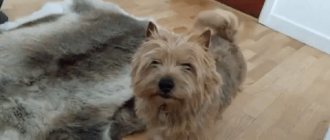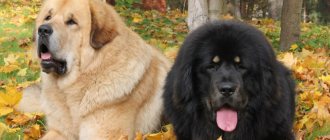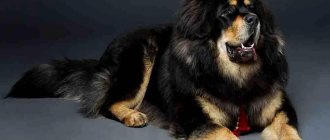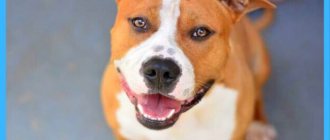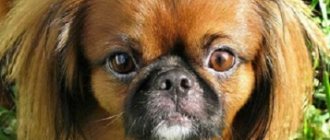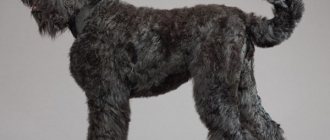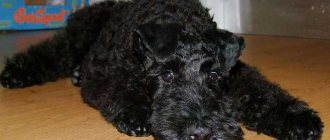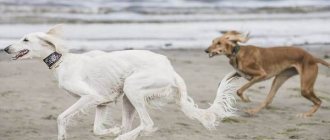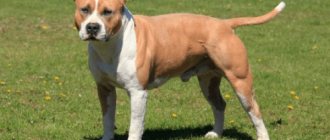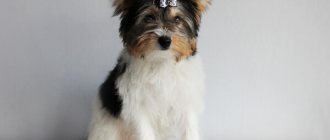Tibetan terriers are becoming increasingly popular in Russia. The aura of mystery around the breed only fuels interest in these unusual dogs. And there really is something to be surprised about: the indigenous people of Tibet value their four-legged friends very much, they treasure them as the greatest treasure of the nation, because for them they are not just dogs. Let's find out what features this breed has.
Brief history of origin
The name of this breed in Tibet sounds like “Tsang Apso” and means “shaggy dog from the province of Tsang.”
The biggest mystery of these smartest shaggy people is their origin. There is no absolutely accurate information about this to this day, but there is an assumption that among the ancestors of the Tibetan breed were Northern Kunlun mountain dogs. Even Tibetan monks do not have more detailed information.
Interesting! It was not by chance that we started talking about monks. Tibetan terriers are the property of Tibetan temples. Here they were considered dogs that brought good luck, protected from evil spirits, and were treated with the same respect as people. Representatives of this breed have always been companions of monks, for which they often called them “little people.”
Like any other value that has a sacred meaning, Tibetan terriers were protected from prying eyes and certainly not distributed among people strangers to the monks. It was possible to get a dog of this breed only as a gift for any valuable services to the temple and its servants. But if someone became the happy owner of a sacred dog, then good luck and protection from universal evil were “guaranteed” - the owner of the Tibetan terrier was known as the favorite of the gods.
In Europe, the first Tibetan terriers appeared only in the late 20s of the 20th century. It was here that the name “terrier” stuck to them. Before that, they were simply the sacred temple dogs of Tibet. In 1957, the FCI recognized the Tibetan Terrier as an independent breed and defined its standard.
Japanese Chin
Despite their name, these dogs were bred specifically for the Chinese imperial house and were subsequently presented by Tibetan monks to the Emperor of Japan. Despite the mischievous look, chinas are very secretive and cold, they demand respect and admiration. The Japanese Chin does not tolerate loneliness and is prone to jealousy.
Chins get very lost in unfamiliar surroundings, so it is better not to leave them alone so that the dog feels the support of its owner.
Full description: Japanese Chin
Interesting Facts
Every dog breed has its own quirks. The Tibetan Terrier is no exception. Below are a few facts that definitely make this breed unique:
- These dogs practically do not shed and do not have a specific dog smell. This makes them especially attractive to people with dog hair allergies.
- Modern Chinese and Tibetans are still convinced that the shaggy national treasure of Tibet brings good luck in business and happiness in life.
- Indians are more pragmatic about temple dogs. Here these are working dogs, whose calling is to guard the home and herd livestock.
Expert opinion
Leonid Rodin
Experienced dog breeder
Ask a Question
The Tibetan Terrier (original name Dhohi Apso) is one of those few breeds whose ancestry can be traced back to the very first dog that came to the Old Continent. In 1922, Dr. Agnes Greig received a puppy as a gift for her medical work in remote mountain villages. The dog came from the line of dogs of a Tibetan lama, so a representative of the aboriginal blood, Dhokhi Apso, came to Europe. A distinctive feature of a real Tibetan terrier can be its paws. Flat feet are shaped like snowshoes. This allows you to easily overcome deep snowdrifts and brittle crust with sharp ice notches. Despite almost a century of history in Europe, where there is no need to wade through snow drifts, the breed has retained this physiological feature.
Shar Pei
Researchers believe that Shar-Peis are related to short-haired Chow Chows because their tongues have a bluish tint. These dogs are smart, majestic, and love to take care of children. In China, Shar Peis are used to rehabilitate children with mental disorders.
Their “wrinkled” faces do not leave anyone indifferent, but do not be misled; these dogs are very brave and are ready to protect their owner at the cost of their own lives. In a family they choose one owner, and they even tend to be jealous of other family members.
Unfortunately, this is one of the most difficult dog breeds to care for; they are prone to a large number of genetic diseases.
Full description: Shar Pei
Breed description, standards and appearance
It is better to seek information about the description of the Tibetan Terrier breed and its standard from professional dog handlers. More often, for such information on any breed, they turn to the sources FCI and RKF - these are the international and Russian (respectively) federations of cynologists.
Their sources provide the following information:
In the FCI/RKF classification, the breed ranks in group 9 (companion dogs), section 5 (Tibetan breeds).
Appearance
Temple dogs have a strong constitution, medium size, a square body, long, thick hair. A strong constitution and square proportions provide representatives of the breed with a well-developed sense of balance.
An adult Tibetan Terrier looks like a miniature Old English Sheepdog.
- The shape of the head is harmonious - the skull has an interesting shape, occupying an intermediate position between round and square.
- The eyes are large, dark in color, widely spaced.
- The ears are shaped like the Latin letter "V".
- The ligamentous apparatus is strong, the muscles are well developed.
- Height at the withers ranges from 32 to 41 cm, weight – from 8 to 13 kg.
Color and coat type
The coat of Tibetan terriers is a special expense item. Long and thick, taking a long time to grow, it requires the expenditure of money and time for care. But the effort is worth it. A Tibetan Terrier with a well-groomed coat is simply a work of art.
Important! FCI and RKF colors allow any, with the exception of chocolate. Therefore, the variety of different shades makes this breed unique.
Shih Tzu
These dogs are of Tibetan origin, their name translates as “lion cub”. It is unknown from which breeds the Shih Tzu originated; according to legend, these dogs were given to the Chinese Emperor by the Dalai Lama, which is why for many years these dogs were bred only in the imperial family.
The Shih Tzu's coat differs from other dogs in its luxury and silkiness, and the hair on the head resembles chrysanthemum petals.
Shih Tzus are very positive dogs, they never bite, and express their protest with loud barks. They belong to long-lived ornamental breeds, the average life expectancy is 14-17 years .
Full description: Shih Tzu
Character and behavior
Nature has awarded Tibetan terriers with a balanced temperament. They are friendly and affectionate towards people, but will become noticeably jealous if another contender appears for their master's attention.
Tibetan Terriers are distinguished by their remarkable intelligence. Smart, emotional “owners” strongly resemble spoiled children of 3-5 years old. Therefore, from puppyhood, representatives of the breed need a firm hand and a kind heart of the owner.
With sufficient attention from a person, with the help of an experienced dog handler or breeder, terriers are highly trainable.
Despite the fact that friendly Tibetan Shags are very active and require physical exercise and long walks, they are perfect for keeping in a comfortable apartment or house. Terriers have a powerful protective instinct in their character. Therefore, representatives of the breed make excellent watchmen and shepherds.
Breed and children
Tibetan terriers' relationships with children are not entirely straightforward. On the one hand, they are tolerant of them, they allow them to play with them, even pull their fur and ears. On the other hand, children for representatives of the Tibetan breed are rivals in the fight for the owner’s attention.
The thing is that dogs are pack animals. For most pets, a family is a pack where there is a clear hierarchy. There is a leader of the pack, there are his “deputies” and the rest of the pack members who need the care of stronger adults.
So the children in the family are the same “rest” members of the pack who need care and protection. You need to remember this constantly; you should not allow the terrier to “be in charge” in this matter.
Pekingese
These dogs are the most popular Chinese dog breed in the world, and a few hundred years ago, owning such a dog was the prerogative of the Chinese imperial family, moreover, these dogs were considered the reincarnation of Buddha.
Pekingese have a complex character ; in the house they consider themselves the only leader and master; they are not at all suitable for families with children, as they do not tolerate rivals.
Due to the peculiar structure of the skull, they have difficulty breathing, so their sleep is accompanied by snoring, and the respiratory organs themselves are the weakest point in the dog’s body, these dogs also do not tolerate heat and cold well, they should not overheat during physical activity.
Full description: Pekingese
How to choose the right puppy?
The basic rule is to buy puppies only from trusted nurseries, from trusted breeders. This approach guarantees that the puppy will be from a planned litter, from purebred parents.
Conscientious nurseries and breeders sell puppies at a higher price than little-known sellers. This is explained by the fact that trusted sellers pay serious attention to breeding issues.
All dogs, like people, are different. Each dog is born with a certain temperament, on the basis of which its character is subsequently formed.
How to choose a puppy that would be suitable for its owner, and that would also be healthy? This is a very important question, because... Having made a mistake at this stage, in the future everything may turn out to be more difficult than imagined.
Of course, when choosing a puppy, it is best to use the help of an experienced dog handler, but not everyone has this opportunity and not always. Here are some tips for this case:
- Even before going to the breeder, decide who you would like to adopt - a boy or a girl? It is usually easier for women to “agree” with a male pet, and for men with a female one, but this is not a statement, but rather an observation.
- First, look at all the puppies in the litter together. Pay attention to how they behave towards each other. Throw something heavy and loud on the floor, such as a set of keys. The most promising puppy is the one who is not afraid, but runs up and sniffs the keys.
- After viewing the entire litter, you need to separate the puppy you like from the rest and observe how he will behave without his brothers and sisters, whether he will show interest or be scared, how quickly he will cope with fear, how quickly and willingly he will make contact with a stranger... This is important for education and training in the future. Such simple “experiments” will give an idea of how strong and strong the puppy’s nervous system is, how balanced the processes of excitation and inhibition in the central nervous system are.
- Next you need to check the physical condition of the puppy. In the case of the Tibetan Terrier breed, special attention should be paid to the cleanliness of the eyes, ears and skin. Pay attention to how the puppy moves, whether there are any awkward, limited movements, or shortness of breath. Ask the breeder how the puppy goes to the toilet and what his appetite is - deviations from the norm are unacceptable for any breed.
- Try to find out from the breeders about genetic defects and diseases of the puppy’s parents and grandparents. The fewer there are, the better and the more expensive the puppy may turn out to be.
- Don't forget to check your puppy's papers. This is a puppy card with the signature and seal of the breeder and a veterinary passport indicating the preventive measures taken - deworming (treatment against internal parasites), disinsection (treatment against fleas), vaccination.
Exterior
There are 2 types of German Shepherds in China. They are completely different in appearance, although a certain similarity can be seen in them, because their ancestors are still the same German shepherds.
There are two types of “Germans” recognized in the PRC:
- Kunming (a light and nimble dog that perfectly shows its working qualities, has a light frame with a fairly high height at the withers, about 65 cm, the dog weighs about 35 - 37 kg, by color they distinguish between saddle-backed, zoned and almost black pets);
- German Shepherd of Chinese breeding (large animals with a massive head, their weight can reach 70 kg; there is a version that in their blood, in addition to the base from German shepherds, there are impurities from the Tibetan mastiff).
Important! The first variety shows itself well in operational and rescue activities, the second variety is an excellent guard, somewhat slow, but no less formidable.
Adults
In appearance, the Chinese-bred shepherd resembles a “German” crossed with a mastiff. It has a large head, a shorter muzzle with a non-pointed nose, a powerful and wide chest, and stronger paws. The animal is slightly heavier than its purebred relatives, and slower. However, its large size and intimidating appearance make it possible to effectively use it as a security guard.
From the usual shepherd dogs, the dog has erect ears, in most cases a sable-colored coat with a dense undercoat. The tail is saber-shaped and droops down. The back and croup are wide, powerful, the angles are sharp and pronounced.
Puppies
Shepherd puppies bred in China differ little from purebred “German” babies. Almost all of them are born almost black in color and in the first month they are almost no different in size and power from their relatives from Germany.
A little later, the babies acquire angular outlines of the muzzle, the head and body become powerful, and the clear outlines of mastiffs, whose blood is mixed with this breed, become visible. The color of the coat becomes black by 2-3 months and subsequently remains virtually unchanged.
Caring for puppies
Everything is standard here. Tibetan Terrier puppies are not much different in care from other breeds or even outbred. You must immediately prepare yourself for the fact that for the first 6 months you will have to run around with a cloth at the ready, hiding all your shoes and bags as high as possible.
In general, you need to be prepared for the fact that the house may undergo unpleasant changes in the form of a damaged interior. Until the dog reaches the age of 10-12 months, all these “joys” are inevitable, however, even an adult representative of the Tibetan Terrier breed can chew on everything.
After the necessary vaccinations have been completed and the veterinarian allows him to go for walks, the baby’s accustoming to walks begins. Toilet training on the street proceeds differently for everyone, but usually by 6-8 months a puppy of this breed is already accustomed to doing “its own business” during a walk.
By about 11-12 months, puppies of this breed reach sexual maturity, but it happens that they reach puberty by 8 months. This does not mean that your dog needs to be mated urgently (it is better to do the first mating at 1.5 years old, not earlier). This means that now other dogs are interesting to your pet not only as play partners, but also as representatives of the opposite sex.
At approximately 1.5-2 years, a dog of this breed becomes fully adult. By this age, the skeleton and all body systems are fully formed, and function in a coordinated and smooth manner; the terrier stops growing “in length and height”, and grows “in width”, in other words, it matures.
Important! Until adulthood, the puppy experiences the most energy-intensive period - the period of growth and development. Right now he needs to be provided with adequate feeding and veterinary care. Investing effort and money in your dog at this stage will pay off in the future. This will be expressed in good physical health and a healthy psyche of the dog.
Lhasa apso
The breed has a thousand-year history, its homeland is the mountains of Tibet, the strong legs of these dogs miraculously climbed mountains, and a good coat protects them from cold and heat.
Apso are extremely distrustful of strangers, sense danger from afar, and in difficult situations can make their own decisions.
It is not easy to train such a dog; due to their suspiciousness and independent nature, it is very difficult to find a common language with them. Obedience can only be achieved by acting persistently, but very gently; it is very important to establish clear discipline.
The coat of the Lhasa Apso is an indicator of proper nutrition; if the diet is incorrect, the coat immediately becomes dull and falls out.
Full description: Lhasa Apso
Care and maintenance of an adult dog
Caring for an adult Tibetan Terrier is easier than caring for a restless puppy. It’s not even simpler, but rather more stable: the diet is formed and does not require significant adjustments, feeding and walking are according to the schedule, grooming of the representative of the breed is worked out to the point of automaticity.
The right diet
Proper feeding is the basis of health. The diet of a puppy of this breed needs to be adjusted according to the growing needs of the body. It is important that all substances are balanced and together provide the optimal amount of kcal.
Typically these are high-calorie diets, rich in protein, carbohydrates and vitamin-mineral complexes.
It is very important to adhere to the feeding schedule and avoid overeating.
For an adult dog of this breed, the diet is balanced in proteins, fats and carbohydrates. Vitamins and minerals should also be included. The older the pet, the less fat in her diet. For dogs of mature age (7 years +), the diet focuses on protein and mineral-vitamin complexes, because Metabolism in adult animals is no longer as active, and minerals and vitamins are absorbed worse than in puppyhood.
Among “dog lovers” there are two types. Some care for the natural type of feeding, others for dry complete food. Both types have their own “+” and “–”, and each owner himself chooses the optimal type for his dog.
- Natural feeding involves the use of natural products: lean meat, eggs, fish, cereals, sometimes offal (but not all!), unsweetened fermented milk products. Most often this is the preparation of porridges with meat and vegetables, with the addition of eggs and fish. The preferred cereals are oatmeal, millet, barley, and rice. In addition to all the listed products, puppies must include cottage cheese in their diet.
- The dry type of feeding involves feeding with ready-made complete dry food, which differs in type of animal, size and age.
If it is difficult for the owner to decide how best to feed the dog, then the surest way to make the right decision is to consult a veterinarian or an experienced breeder who knows the characteristics of the breed.
Important! Under no circumstances should you allow your dog to be fed food from the owner’s table! What is tasty for the owner is harmful for his dog.
Feeding
The basic rule of Tibetan nutrition is a complete ban on food from your table. Such feeding and treats will lead to the development of obesity and gastritis. For an adult dog, it is better to choose a balanced premium ready-made diet.
As for the baby who has just been separated from his mother, it is better to choose natural food with sufficient calcium content. This means that the baby’s menu should include a lot of low-fat fermented milk products.
Basic rules for creating a natural diet:
- diet: puppies should receive food 7 times a day, adult dogs 2 times;
- overeating should not be allowed;
- the basis of the diet should be lean meat (beef, poultry) and offal;
- The diet should include cereals (rice, buckwheat, oatmeal), vegetables and fruits (both raw and stewed);
- The diet should not contain sweets, smoked meats, potatoes, corn, legumes, or sharp tubular bones.
It is useful to give your dog beef bones or special store-bought bones to cleanse the teeth of deposits.
Photo: pixabay.com
Walking and physical activity
The Tibetan Terrier is an active dog with well-developed muscles. This means that walking is no less important for her than proper nutrition. Ideally, you need to walk with an adult Tibetan for at least 3 hours a day - twice for 1.5 hours.
Moreover, it is advisable not to just walk slowly, keeping the dog next to you on a leash, but to give the dog the opportunity to run around to his heart’s content without a leash, play tug-of-war with him, with fetch, or in some other way.
A lack of walking (especially in combination with overeating) will lead to physical inactivity, and consequently to obesity and all its consequences. Most often, this is not only excess weight, but also problems with the cardiovascular system, breathing, and musculoskeletal system.
If there is a lack of exercise, by the age of 5 the dog will have a number of chronic diseases.
Training and education
It is necessary to begin raising a puppy from the moment contact is established with him.
The first steps in raising a puppy are to teach him his name and basic commands:
- "Place!" – the requirement for the dog to go to its place;
- "Ugh"! – a command prohibiting any unwanted actions;
- "To me!" – requirement for the dog to approach the owner;
- "Near!" – a requirement for the dog to move next to the owner at his left leg.
You should also accustom your pet from puppyhood to brushing (for the Tibetan terrier this is extremely important) and examination by a veterinarian (eyes, teeth, body, thermometry).
Important! From the first days, the puppy needs to be shown who is the leader in your “pack”. Only after your leadership has been accepted can you achieve submission and obedience, which will be of great importance in the future in the relationship between the dog and your family members.
If problems arise at any stage of training, then it is better not to experiment, but to contact a professional dog handler.
Care and hygiene
Hygienic care of Tibetan terriers consists of several points:
- wool,
- eyes,
- ears,
- claws,
- teeth.
The coat of dogs of this breed is simply unique. It is long and silky, in addition there is also a thick undercoat.
Tibetan Terriers practically do not shed. Perhaps their shedding goes unnoticed due to the fact that it is recommended to comb such a coat at least once a week, otherwise tangles will form.
If the coat is excessively dry and difficult to comb, it needs to be slightly moistened with a spray bottle of water or a special lotion.
Tibetan terriers are washed and groomed once every six months. The skin of dogs of this breed is highly sensitive, so the shampoo is applied directly to the coat, being careful not to touch the skin. The same goes for a special wool conditioner.
If washing is a troublesome and unpleasant task for the owner, then it would be best to visit a groomer.
The eyes of Tibetan terriers are hidden under the bangs. This does not affect vision in any way, but eye care is required daily. With the help of special lotions and cotton pads, normal daily discharge from the eyes can be easily removed.
Instead of lotion, you can use saline solution or boiled water, but lotion is still preferable.
Your pet's ears also require hygienic care. It is necessary to regularly check the ears for dirt and inflammation. Since Tibetan terriers have drooping ears, the predisposition to otitis media in representatives of the breed is high.
You can clean the ears with cotton pads and swabs. Special lotions are used as a cleanser, but in addition to them, a 1% chlorhexidine solution or miramistin solution is suitable.
Attention! The dog will feel more comfortable while cleaning its ears if the cleaning product is slightly warmed in a water bath!
Claws must be trimmed in a timely manner, otherwise they will split, break off and be injured. In the worst case, such an injury can develop into osteomyelitis of the finger.
Teeth should ideally be brushed with a special toothpaste for animals and a toothbrush – either a specialized one or a children’s brush (for children under 3 years old). If you do not pay attention to your teeth, then tartar forms on them, which has to be removed in a veterinary clinic with ultrasound, and sometimes even under anesthesia.
If this is not done, periodontitis develops due to tartar, and the dog may lose its teeth.
Chongqing
One of the oldest Chinese breeds on the planet. There are many sculptures of the dog in the tombs of ancient emperors. Chongqing people idolize their master, but they treat strangers with great caution. It is better not to keep such a dog with other dogs, and they generally hate cats. They treat children well; they can be safely left with even the smallest children.
Their diet should not consist of dry food, only natural products. Life expectancy is 19-20 years .
Pros and cons of the breed
The table, which takes into account the main features inherent in all dogs of this type, will help you decide whether the Tibetan Terrier is right for you.
| pros | Minuses |
| If the Chinese and Tibetans are not mistaken, then Tibetan terriers are living talismans for good luck and happiness. | Puppies require special attention. These are endless puddles on the floor, chewed furniture and shoes. |
| Very calm, reasonable and friendly, not jealous of other pets and children. | Wool requires painstaking care. But if you don’t start it, then care ceases to be a problem. |
| Excellent watchdogs for the home. | |
| They practically do not shed, despite their rich coat. | |
| They are active and love walks. This means that they can make excellent company while jogging or hiking. |
Tibetan Terriers are excellent companions and loyal friends. Dogs of this breed, shrouded in the mystery of time... They have a strange origin, they live in temples, they are revered by Tibetan monks, they know how to bring happiness and good luck.
Theses
- These are great dogs, but it is best to keep them in a home where the children are older.
- They get along with other dogs and cats, but can be jealous.
- Requires care and frequent washing.
- Tibetan Terriers can be good guard dogs, warning of the approach of strangers.
- If you walk them daily, they get along well in an apartment.
- They are extremely attached to their family and cannot tolerate separation, loneliness, or lack of attention.
- Barking is the Tibetan Terrier's favorite pastime. He barks when someone comes to the door, when he hears something unusual and if he is bored.
Mating
To obtain offspring, it is better to contact a kennel club. Both the female and the male must have show grades that are sufficient for breeding.
The first mating can be carried out when the female has reached the age of 1.5 years, and the male has reached 1 year. But it is still better to postpone mating until the age of 2-2.5 years, because that is when the body reaches full maturity.
Important! You can introduce a couple on a walk, but for mating you should prefer the territory of the male.
The breed should be prepared in advance for mating by choosing a high-quality pair
Nutritional Features
As a rule, individuals of this breed do not suffer from problems associated with the digestive system, therefore, you can choose any brand as an industrial feed. If the owner has time to prepare food for the animal, then it is better to choose a natural diet.
The basis of a natural diet is meat and low-fat varieties of offal. Occasionally, you can give the animal boiled sea fish, after removing the bones from it. The diet is also based on porridge and vegetables.
It is strictly forbidden to feed boiled eggs, cottage cheese and any fermented milk products. Any sweet, fried, spicy or fatty foods are prohibited.
General health problems
Although Tibetan Terriers are known for their longevity, they, like most breeds, can be susceptible to certain genetic health problems.
To minimize the likelihood of developing them, you should always look for a reputable breeder who conducts health checks on the puppy's potential parents.
Some of the diseases they are prone to are:
- Vision problems: These include cataracts, progressive retinal atrophy (PRA) and lens luxation
- Hip dysplasia: This is when one or both hip joints form abnormally. The problem progresses and in severe cases surgery may be required to increase mobility and reduce pain.
- Hypothyroidism: This is when your dog has an underactive thyroid gland and this slows down his metabolism. Symptoms may include weight gain, hair loss, lethargy, skin problems and even behavioral changes. Although there is currently no prevention, once diagnosed, it can be effectively managed with medication.
- Luxating Patella: Caused by the kneecap slipping out of its groove, this problem can vary in severity. In some cases, this may only happen occasionally and then easily return to the same place. In the most severe cases, it will remain permanently outside the groove and will require corrective surgery to improve the dog's quality of life.
Tibetan Spaniel
These dogs can become both guard dogs and companion dogs. Spaniels are completely non-aggressive, and love their family very much, but they are wary of strangers.
Unfortunately, this breed has a genetic predisposition to discopathy and allergic dermatitis, so you need to be very careful when preparing your diet.
During training, the main thing is to show patience and perseverance; if you show physical force to the dog, then trust will be lost forever.
Full description: Tibetan Spaniel
